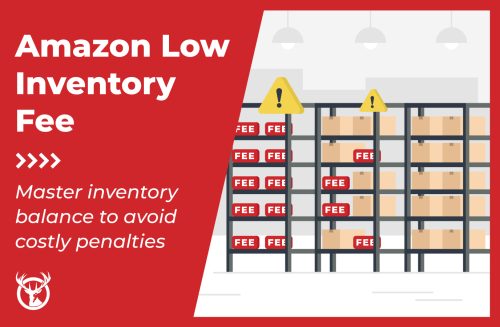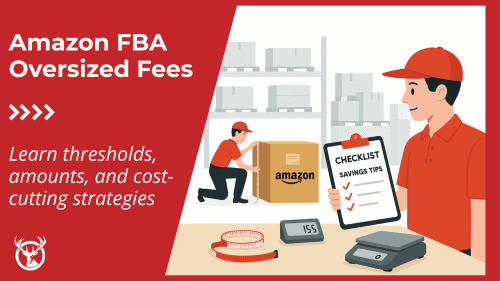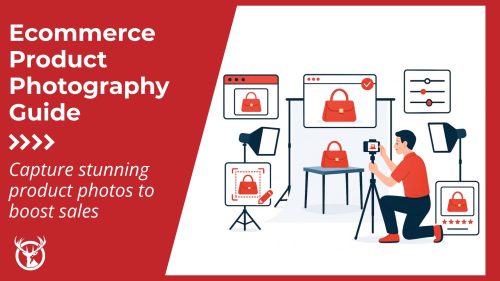Amazon’s Seller-Fulfilled Prime (SFP) program lets vendors display the Prime badge on their products while maintaining control of their fulfillment process. With Amazon’s third party sellers generating billions in annual sales, this program offers significant growth potential. But the strict delivery requirements and nationwide shipping mandates mean SFP isn’t right for every business.
This guide will help you determine if Amazon Seller Fulfilled Prime aligns with your business goals and capabilities. We’ll examine the program requirements, compare it to other Amazon fulfillment options, and outline the steps to join if you decide it’s right for you.

If you need help with Seller Fulfilled Prime, reach out to Red Stag. We specialize in SFP for large and heavy items, along with Fulfilled by Merchant (FBM) and FBA prep services.
And if we’re not the right fit for your Amazon business, we’ll connect you with a 3PL that is.
What is Amazon Seller Fulfilled Prime?

Seller Fulfilled Prime
Seller Fulfilled Prime (SFP) is an Amazon program that lets vendors earn the Prime badge while handling their own shipping from their own warehouse or through a third-party logistics provider (3PL). Unlike Fulfillment by Amazon (FBA), SFP gives sellers complete control over inventory and fulfillment while still offering the benefits of prime shipping to customers.
With SFP, sellers can have the prime badge displayed on their products, indicating they are eligible for Prime’s fast and free shipping options. This program also enables sellers to offer one- and two day shipping options for customers, enhancing the shopping experience.
Amazon first launched Seller Fulfilled Prime (SFP) as an alternative to its Fulfillment by Amazon (FBA) program in 2015 as a way to increase the availability of products to Prime Members while allowing sellers to take over control of the fulfillment process. The quality of delivery experience dipped as more and more retailers joined SFP, so Amazon allegedly paused enrollment around 2020.
Amazon released an updated set of guidelines for seller-fulfilled Prime in 2023, and the program officially reopened enrollment in October, 2023.
With this re-launch, there’s a crucial question any online vendor needs to ask: Is the seller fulfilled prime program worth it for my business?
The answer — it depends.
But before we fully answer that question, it’s important that you know the different ways an Amazon seller can sell products on the platform.
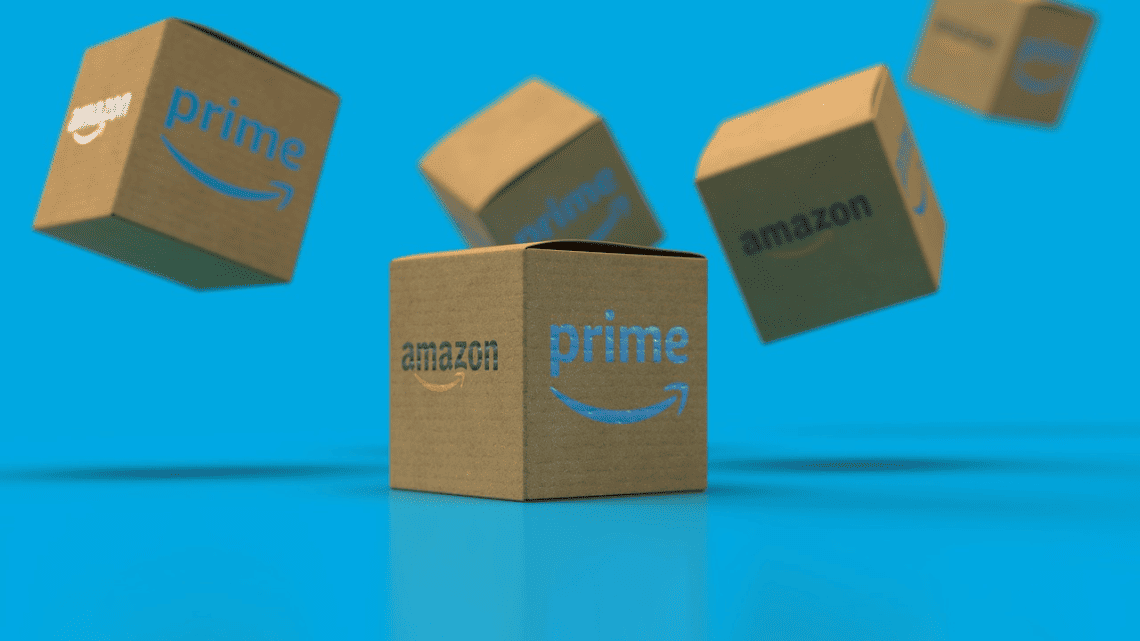
What’s the Difference Between Fulfillment by Amazon (FBA), Merchant Fulfilled Network (MFN), and Seller Fulfilled Prime?
One of the first decisions a seller makes when joining Amazon is how to get their products to customers. Basically, it comes down to this question: will you pay Amazon to do it or handle the fulfillment yourself?
Fulfillment by Amazon
Fulfillment by Amazon (FBA) is a service where online retailers store their products at Amazon’s warehouses. This means Amazon takes over the fulfillment services for the company, handling tasks such as picking, packing, and shipping the product, as well as managing customer returns and support. Products under this program are displayed with the Prime badge, signaling fast and free shipping options to customers.
However, the convenience of FBA comes at a cost, with retailers required to pay fees for storage, fulfillment, returns processing, and other actions. The screenshot below shows some example costs from the Amazon FBA fulfillment fees page:
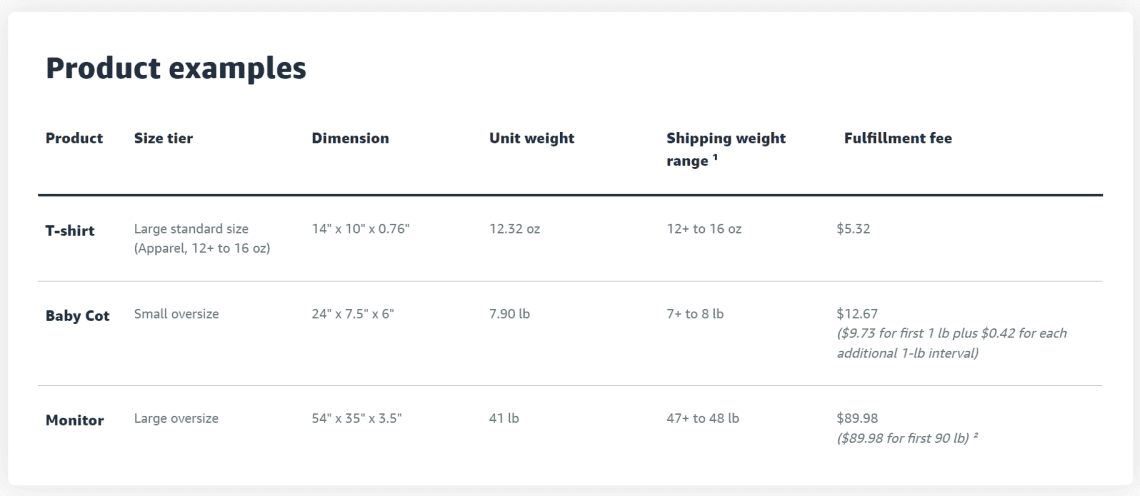
If you want to fulfill the shipment yourself, there are two fulfillment options available:
Fulfilled By Merchant (FBM/MFN)
In the Amazon Merchant Fulfilled Network (MFN), also known as Fulfilled by Merchant (FBM), sellers list their products on the Amazon marketplace and are responsible for filling the orders themselves. Once a purchase is made, a notification is promptly sent to the seller’s Amazon account, alerting them to fulfill orders. This fulfillment process entails the seller personally packing and dispatching the product to the customer within a specified time frame.
Sellers take on the responsibility of managing customer service inquiries and overseeing the returns process in FBM, thereby offering a more personalized customer service experience.
The arrangement also gives merchants the autonomy to determine their own pricing and shipping strategies, which provides more control.
Seller Fulfilled Prime
Similarly, Seller Fulfilled Prime lets vendors fulfill deliveries themselves or employ certain third-party logistics (3PL) providers. But, to Prime customers, SFP products are indistinguishable from FBA ones. Both are adorned with the coveted Prime Badge and promise free two-day (or faster) shipping for customers.
Theoretically, this scenario creates a win-win situation for both Amazon and the seller. While Amazon saves on storage space and overhead costs, SFP sellers bypass the substantial fees associated with FBA and take back control of the customer experience.
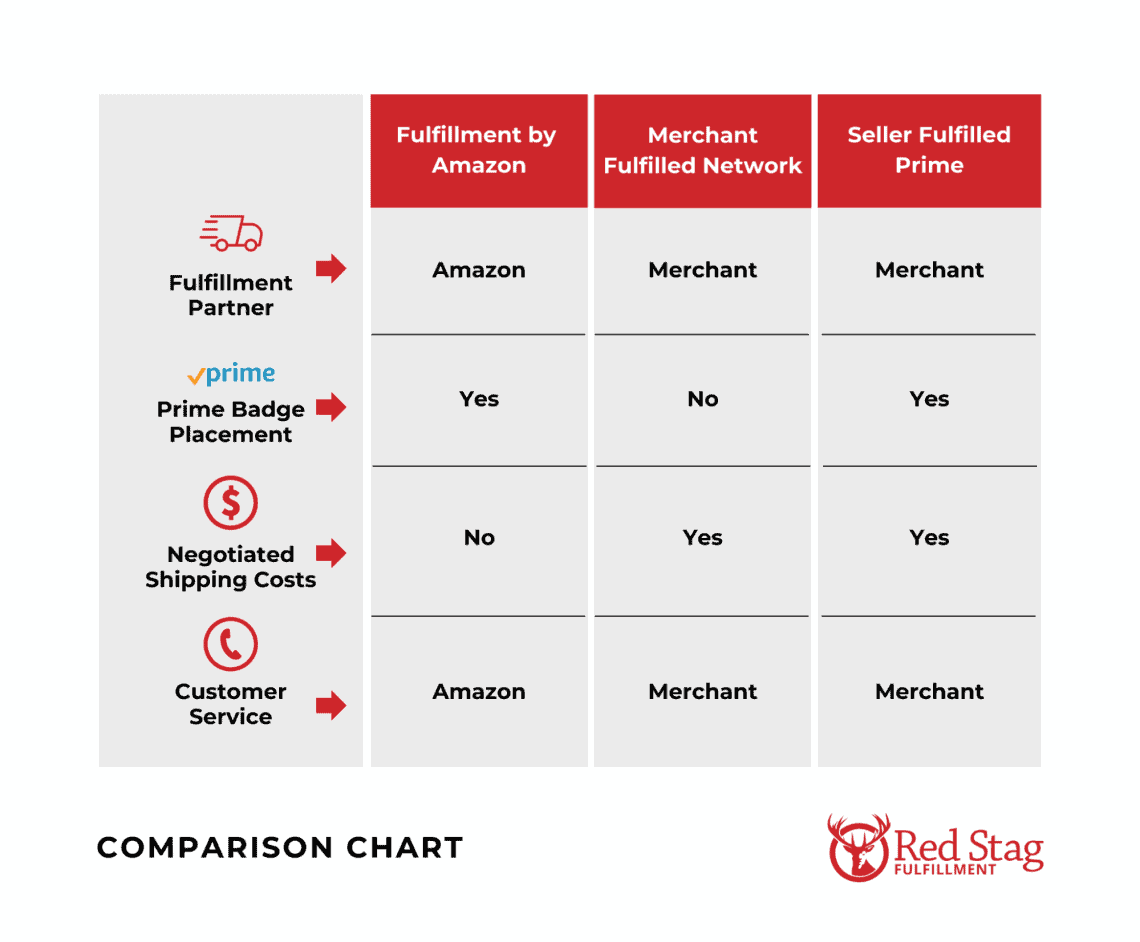
In reality, it’s more of a trade-off. Seller fulfilled Prime offers the advantage of the Prime Badge and lower fees than FBA, but Amazon also levies stricter, potentially more costly requirements than FBM — more on this later.
What are the Benefits of Seller Fulfilled Prime?
The online retail landscape is incredibly crowded — with an estimated 2.5 million “etailers” in the United States alone. Achieving maximum exposure is key to attracting and retaining customers. This is where Amazon can be a game-changer.
Putting your products on Amazon does increase your exposure to customers, but joining the Seller Fulfilled Prime program can help you unlock another level of success. Here’s why:
✔ Reach the Most Loyal Amazon Customers
Being a part of the SFP program allows you to reach Amazon’s most loyal customer base: Prime members. These members are known to spend significantly more than other Amazon users — up to 3 times more, by some estimates — making them a lucrative target audience for your products.
By joining SFP, you not only get to showcase your products to this premium customer base, but you also increase the chances of your offer being featured over competitors, thanks to the preference Amazon’s search engine gives to Prime products.
✔ Prime Badge: A Symbol of Trust and Quality
One of the standout benefits of joining the SFP program is getting that little blue Prime Badge next to your products. This badge is more than just a symbol; it’s a signifier that customers have come to associate with quality and reliability.
In fact, the inclusion of the Prime Badge can increase shopper conversion by an impressive average of 20-25%, making it a potent tool for enhancing your business’s visibility and sales on the platform. And, if you’re an Amazon Prime customer yourself — think about it — how many times have you decided to purchase one product or another due to one having that Prime badge?
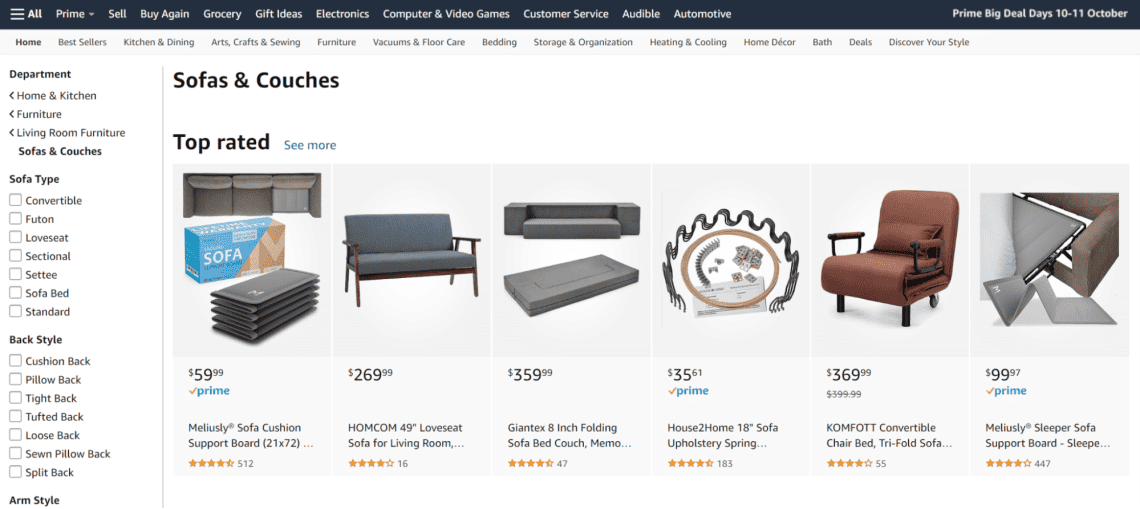
✔ Enhanced Customer Experience with “Free Delivery” Messaging
In the world of online shopping, the promise of free delivery is a significant motivator for customers. A Digital Commerce 360 study recently found that offering free shipping and returns is the most important purchase factor for 70% of customers.
As a Seller Fulfilled Prime member, you can reap the benefits of Prime’s “free delivery” messaging on all your product listings. This not only attracts customers but also enhances their shopping experience, potentially leading to higher customer satisfaction and repeat business.
✔ Increased Brand Recognition
Joining the SFP program can also lead to increased brand recognition as you get to showcase your products to a wider audience of Amazon shoppers. Amazon reports that 75% of its shoppers use the marketplace to find new brands, and 52% are willing to buy an unfamiliar brand.
If you’re still trying to grow your brand on social media and other sales channels, getting into the Amazon network is a great way to gain access, especially with the Prime Badge.
✔ Storage Savings and Inventory Control
One of the significant drawbacks of the FBA program is the high storage fees that sellers incur. By opting for SFP, you can save on these expensive storage and shipping fees by finding a trusted 3PL with lower prices or use an in-house fulfillment solution. With the right partnership, you stand to increase the profitability of your arrangement with Amazon. The savings can be a game-changer, especially for merchants with products that have unpredictable or seasonal demand, slow-moving goods, or oversized and heavy items that require special handling and preparation. Of course, all of this is part of understanding how Seller Fulfilled Prime work.
Of course, it’s not all sunshine and roses in the Seller Fulfilled Prime program. Take a quick look at some of the comments from SFP members in the Seller’s Forum discussion and see an unfiltered view of SFP member perspectives:

Let’s take a look at some of the potential drawbacks of joining the SFP program.
What are the Cons of Joining Seller Fulfilled Prime?
Before you decide to join SFP, it’s essential to be aware of the potential drawbacks that might influence your business operations. You will need to evaluate your products, margins, location, fulfillment capacity and partnerships, and long-term goals to determine whether this is the best option for your business.
Here, we highlight some of the cons based on the experiences shared by current and previous SFP participants:
🗙 Lofty Performance Metrics
Amazon paused enrollment in the SFP program due to concerns about members not upholding the high standards expected for Amazon Prime deliveries. Amazon sets a high bar for getting and maintaining the SFP status, with stringent requirements to ensure a consistent and high-quality experience for Prime customers. For example, your cancellation rate must be very low.
This means that sellers need to be prepared for increased scrutiny and to meet the higher standards set by Amazon, which might pose a challenge, especially for new or smaller sellers.
🗙 Steep Nationwide Shipping Costs
The new rollout of the SFP program has done away with regional SFP delivery, meaning that sellers are now required to provide nationwide delivery coverage. This change can pose logistical challenges, especially for sellers without a presence on both coasts. It necessitates a reevaluation of your delivery and logistics strategy to ensure nationwide coverage without escalating costs.
One of the significant concerns raised by sellers is the potentially steep shipping costs associated with the SFP program, particularly due to the one- and two-day shipping requirements. This is especially true for those not located centrally within the country.
🗙 Fluctuating On-Time Delivery Requirements
The house always wins, as they say, and Amazon is in full control of the Seller Fulfilled Prime program. So, even in the event that you join SFP and experience a nice bump in sales, Amazon’s current requirements can change just as easily as the previous ones. This can impact your Prime eligibility.
On Amazon’s updated requirements page, the company recently announced that it will review the vendor performance requirements for maintaining Prime status every quarter and give businesses 45 days’ notice before implementing any changes:
“To reflect Prime customers’ expectations, the minimum performance requirements for on-time delivery will be refreshed quarterly. Any change will be communicated at least 45 days before the change is effective.”
While this is done in the name of keeping Prime customers satisfied, it means that vendors need to monitor the program closely and be prepared to eat new costs and fees on relatively short notice.
Now that you’re aware of the pros and cons of joining Amazon’s 2023 Seller Fulfilled Prime program, let’s take a closer look at how you can determine whether or not it’s worth it for your business in particular.
Is Amazon Seller Fulfilled Prime Worth It?
Deciding whether to join the Seller Fulfilled Prime program is a significant decision that can potentially influence the trajectory of your business on Amazon. The answer to whether it’s worth joining is not a straightforward “yes or no” — it depends on various factors, including your product offering, business size, and profit margins, and whether you can ship same day.
In this section, we delve into the nuances that can help you evaluate if SFP is the right choice for your business:
Product Offering
The type of products you offer can significantly influence the suitability of the SFP program for your business. According to Amazon, the program is best suited for sellers offering:
- High-Value Items: Products that have a high price point and can absorb the potentially higher shipping costs associated with SFP.
- Products with Unpredictable or Seasonal Demand: Items that experience fluctuations in demand, making it challenging to manage inventory levels effectively in FBA.
- Items with Variations: Products that come in various sizes, colors, or styles, which might benefit from the more direct control over inventory offered by SFP.
- Slow-Moving Goods: Products that have a slower turnover rate, helping to avoid the high storage fees associated with FBA.
- Products Requiring Special Handling or Preparation: Items that require specific handling or preparation procedures, allowing for more control over the fulfillment process.
In our experience, there are quite a few factors that play into the viability of SFP for vendors. Typically, brands selling oversized products, from furniture to chicken coops, have an easier time navigating the delivery requirements and fees of the Seller Fulfilled Prime program.
Business Size
The size of your business can also play a role in determining the viability of the SFP program. Larger businesses with established logistics and fulfillment processes might find it easier to meet the stringent requirements of SFP compared to smaller businesses or those just starting out. It also helps to have established relationships with a high-quality 3PL that adapts to meet your needs, upholds a high level of customer service, and treats your operation as more than just a cog in a larger machine.
Profitability
Profitability is a crucial factor to consider when evaluating the SFP program. The potential savings on FBA storage fees and the increased control over inventory management can potentially lead to higher profitability. However, it’s essential to carefully calculate the potential shipping costs and other associated expenses to ensure that the program is financially viable for your business.
So, if Amazon Seller Fulfilled Prime still sounds like a good decision for your business, it’s time to look at the requirements and steps for joining the program.
How to Enroll in Seller Fulfilled Prime
Joining the Seller Fulfilled Prime program can be a significant milestone in your business journey on Amazon. But in order to realize those benefits, you need to demonstrate that your business can keep up with the SFP requirements.
Amazon is keen on elevating the standards of the SFP program, especially after receiving feedback from Prime customers about inconsistent experiences. This means that the bar has been raised, and sellers need to meet stringent requirements to be eligible for the program.
Here’s how to enroll as an SFP seller.
Seller Fulfilled Prime Requirements [2023]
To maintain the reputation of Amazon Prime and ensure customer satisfaction, Amazon has set specific requirements that sellers must meet to be eligible for and maintain the SFP status. Here are the key performance requirements that take effect in October 2023:
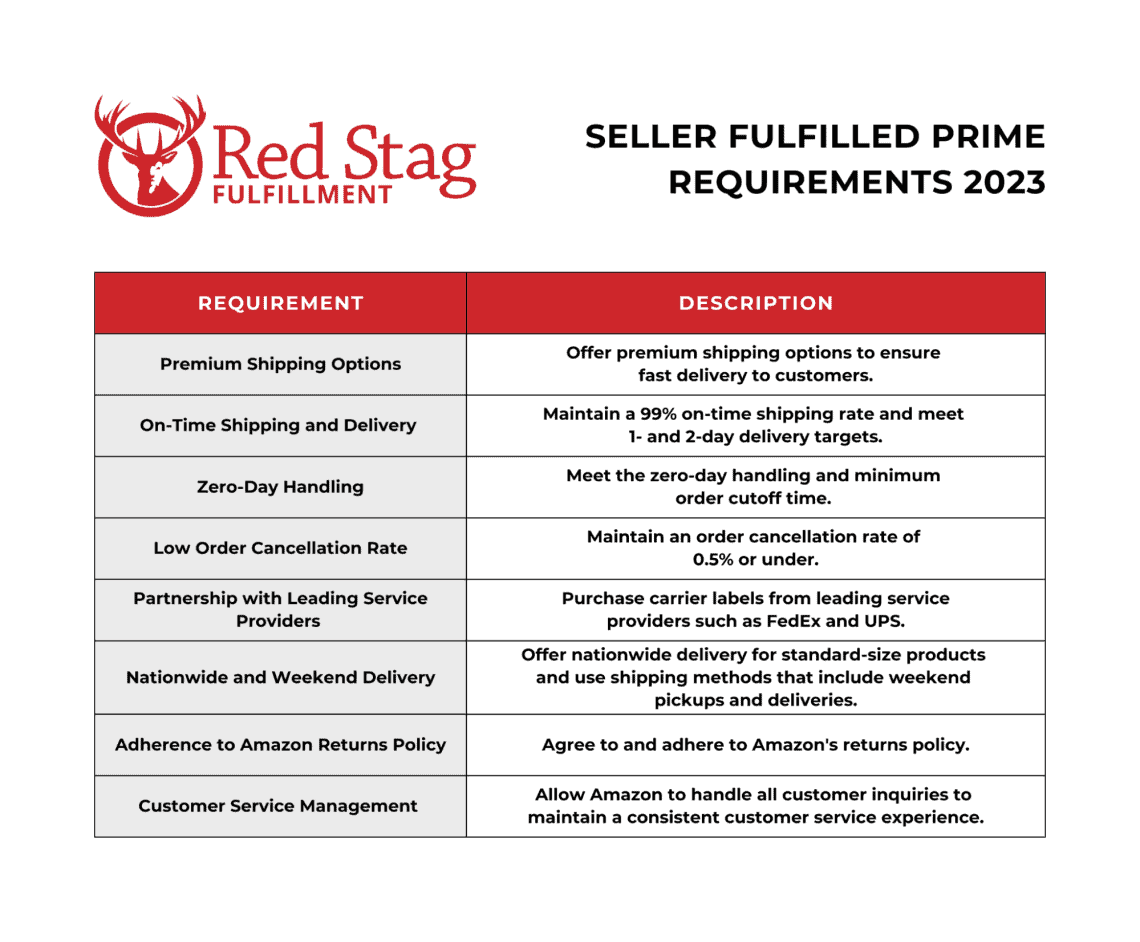
Amazon outlines some general shipping requirements that SFP vendors need to meet based on the size of the product. So, for standard-size products, you need to reach at least 30% of the United States in 1 day or less and at least 70% of the US in 2 days or less. Those numbers drop to 10% and 45%, respectively, for oversized products, and extra-large products only have to reach 15% of the country in under 2 days. To do this, you may need to configure shipping settings in your account.
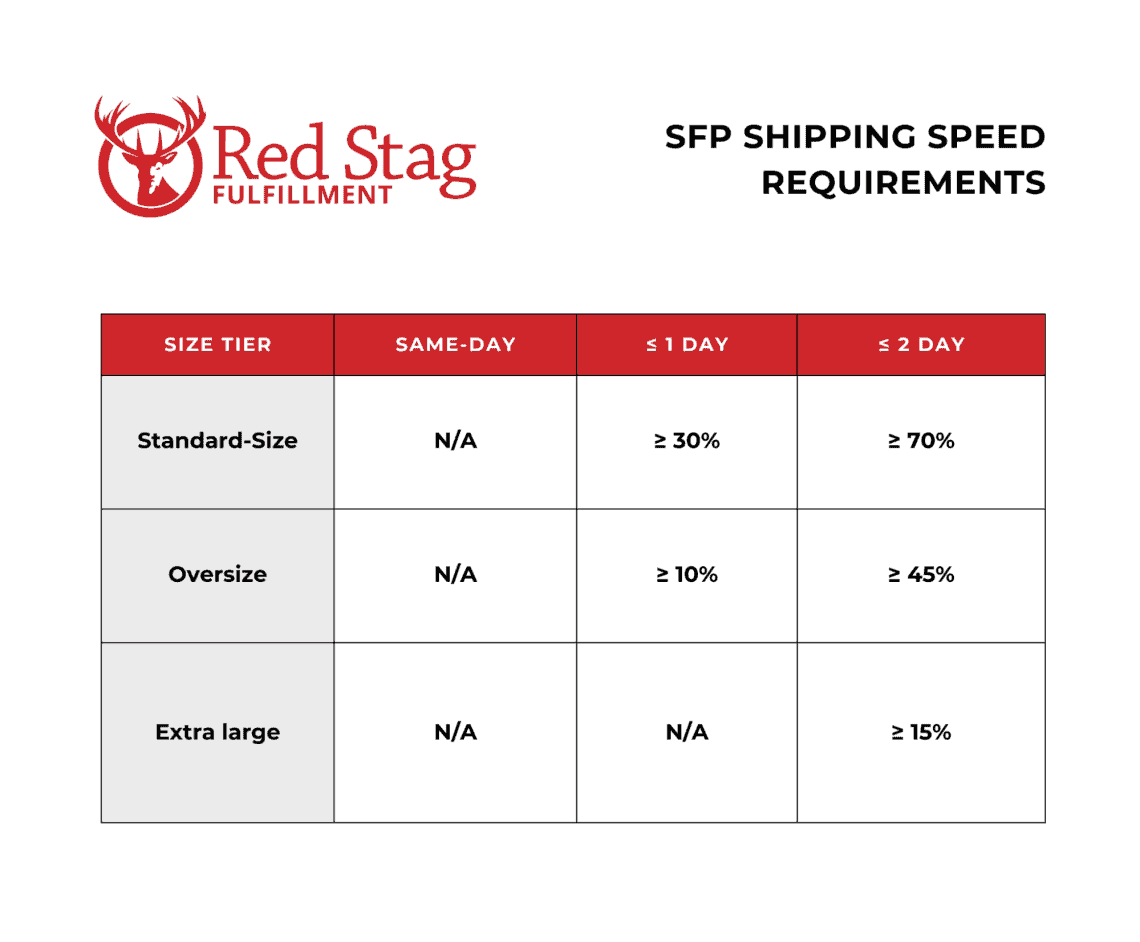
As products increase in size, the shipping speed and range requirements drop, opening up an interesting opportunity for vendors that want to sell oversized products nationwide.
Steps to Joining Seller Fulfilled Prime
Now that you know what the requirements are for Seller Fulfilled Prime in 2023 and beyond, it’s time to take a look at the process for joining the SFP program. Here is a step-by-step guide to help you navigate the process:
- Join the SFP Waitlist: Start by joining the SFP waitlist on Amazon Seller Central.
- Qualify for SFP: Meet the pre-qualification requirements and successfully complete the fulfill Prime trial period.
Pre-Qualification Requirements: Before starting the Prime trial period, you’ll need to ensure that you have a domestic US shipping address and a professional selling account. Plus, you must prove you’ve met the following criteria over the past three months:
- Self-fulfill at least 100 deliveries.
- Maintain a cancellation rate below 2.5%.
- Achieve a valid tracking rate of over 95%.
- Ensure less than 4% of shipments are late.
Pass the SFP Trial Period: If you meet the pre-qualification requirements, Amazon lets you register for the official trial period. The trial period lasts for 30 days and requires that you ship at least 100 Prime trial packages. If successful, you will automatically be enrolled in Seller Fulfilled Prime.
Even if you have previously exited the program, Amazon will let you restart the trial again as long as you meet the pre-qualification requirements.
- Launch Inventory and Order Processing: Store inventory in your own warehouse and process orders yourself, obtaining shipping labels from approved carriers.
- Ensure Fast Order Fulfillment: Pick, pack, and ship Prime orders on the same day to meet the fast delivery targets.
- Meet Your Delivery Commitments: Ensure that orders are collected and delivered within one or two days to meet Amazon’s delivery promises.
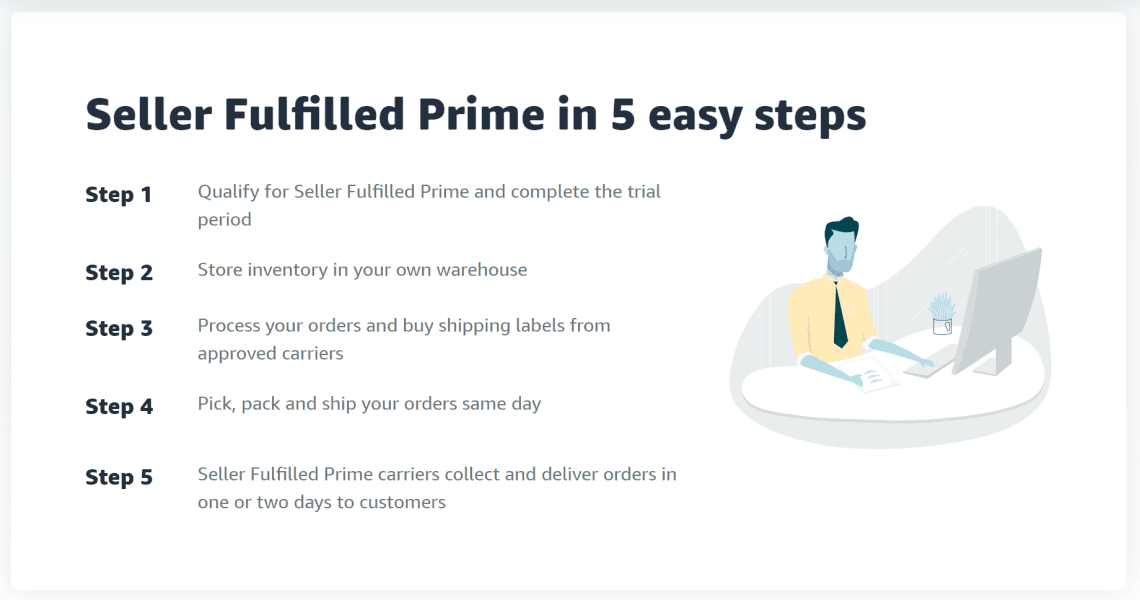
Failure to meet the SFP requirements isn’t necessarily the end of the world. The company has a three-strike policy where vendors who miss the mark first receive an email alert from Amazon, then have a temporary pause on Prime listings, and finally are removed from the program.
For more information on joining the SFP program, you can check out the official Seller Fulfilled Prime page or the upcoming changes page in the Seller Central hub.
Optimizing Your Seller Fulfilled Prime Strategy
Joining and maintaining status in the SFP program is not a one-time effort. It requires continuous adjustments and optimizations to ensure that your business not only meets the stringent requirements set by Amazon but also thrives in this competitive landscape. You can also work with your fulfillment partner to optimize.
Here, we explore various strategies that can help you optimize your business for the SFP program:
Product Pricing
- Competitive Pricing: Regularly monitor the pricing strategies of your competitors and adjust your pricing to remain competitive while maintaining profitability.
- Dynamic Pricing: Consider implementing dynamic pricing strategies that allow you to adjust prices based on market demand, seasonality, and other factors.
- Value Proposition: Enhance your product value proposition by offering bundles or discounts on multiple purchases to attract more customers.
Inventory Management Processes
- Real-Time Inventory Tracking: Implement systems that allow for real-time tracking of inventory levels to avoid stock-outs or overstocking.
- Demand Forecasting: Utilize demand forecasting tools to predict future sales trends and manage your inventory more effectively.
- Automated Reordering: Set up automated reordering systems to maintain optimal inventory levels and avoid potential stock-outs.
Fulfillment Partners
- Choosing the Right 3PL: Collaborate with a reliable third-party logistics (3PL) provider like Red Stag that has experience supporting Amazon sellers and can help you meet the SFP requirements.
- Streamlined Fulfillment Processes: Work with your fulfillment partner to streamline the fulfillment processes, ensuring fast and accurate order processing. A good partner will also offer excellent shipping services.
- Flexible Shipping Options: Offer flexible shipping options to cater to different customer preferences, including expedited shipping for urgent orders.
Frequently Asked Questions About Seller Fulfilled Prime 2023
Before making the decision to join SFP, here are some common questions to consider:
How Much Does Seller Fulfilled Prime Cost?
Joining Amazon’s Seller Fulfilled Prime (SFP) program comes with its own set of financial considerations that sellers must be aware of to effectively gauge profitability and viability. One of the primary costs associated with this program is the program fee levied on each item sold through the SFP.
The program fee structure is as follows: for every Seller Fulfilled Prime item sold, a fee equivalent to 2% of the total price of the item is charged. This fee applies to items sold to a Prime customer via an offer associated with a Prime shipping template. It is important to note that a per-unit minimum fee of $0.25 applies, irrespective of the size tier of the product sold. This means that whether your product falls under the standard-size, oversize, or extra-large category, a minimum fee of $0.25 will be incurred for each item sold.
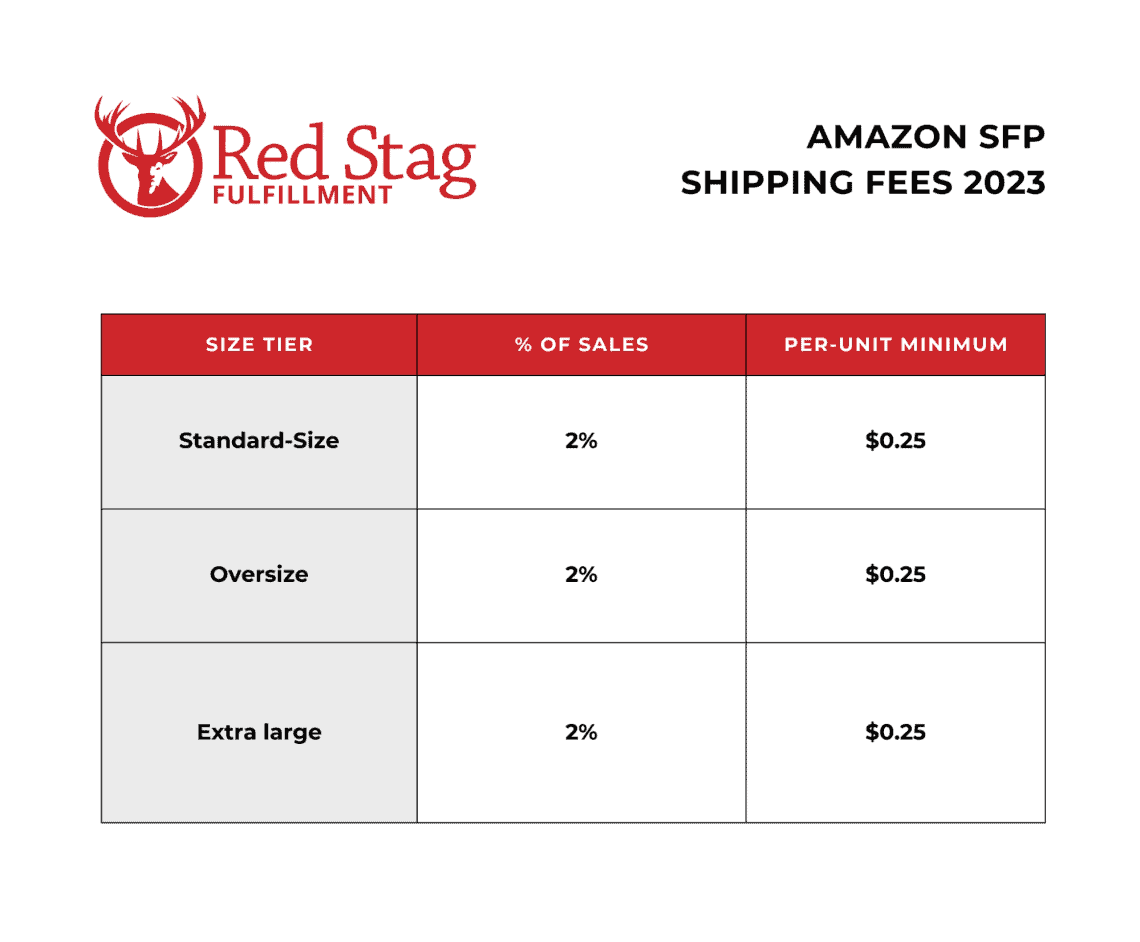
It’s crucial that you take time to crunch the numbers and determine whether these fees are manageable when paired with shipping and other costs, as they directly impact your profit margins.
Which Businesses Benefit Most from Using SFP?
In general, SFP can be great for merchants who can consistently and in a cost effective way offer nationwide 2-day shipping (or less). As mentioned, our experience partnering with vendors selling oversized and extra-large products has shown us that businesses with products in these categories can also be strong candidates for SFP.
Who are the approved Amazon Seller Fulfilled Prime Carriers?
The approved carrier list is available to SFP applicants and members of the Amazon fulfillment network. It includes major US carriers like USPS, UPS, FedEx, DHL, and many others. Amazon is removing the requirement of Amazon Buy Shipping services, so vendors can take advantage of better rates with 3PLs.
Can You Do Prime with FBM?
At the moment, using the Merchant Fulfilled Network does not give you access to the Prime badge on Amazon. If that’s a priority for your business, you will need to consider either SFP or FBA to enable Prime shipping.
Solving your Amazon SFP Fulfillment Needs
It goes without saying that you need to have all your ducks in a row before you apply for the SFP program. Specifically, you need your fulfillment down pat. Considering Amazon’s high bar for vendors, having a reliable fulfillment partner is key to meeting those lofty delivery requirements.
At Red Stag Fulfillment, we have the infrastructure, industry knowledge, and, most importantly, direct 3PL experience to get you into Amazon’s SFP network. Here’s how we help you address your Amazon 3PL & fulfillment needs:
Expertise and Experience: Choose a fulfillment partner that has a proven track record of supporting Amazon sellers, helping them meet the SFP requirements and earn the coveted Buy with Prime badge.
Technology Integration: Leverage technology integrations offered by your fulfillment partner to automate and streamline the order processing and fulfillment workflow.
Customized Solutions: Work with your fulfillment partner to develop customized solutions that cater to your specific business needs and product characteristics. This includes adhering to Amazon’s return policy.
You’ve worked hard to scale and grow your business, and Amazon can be a great platform for further expansion. The Seller Fulfilled Prime program offers a golden opportunity for sellers to tap into the vast Amazon marketplace and reach a wider audience.
By optimizing your business strategies and collaborating with our experienced fulfillment team, you can carve out a successful path in the SFP program.






